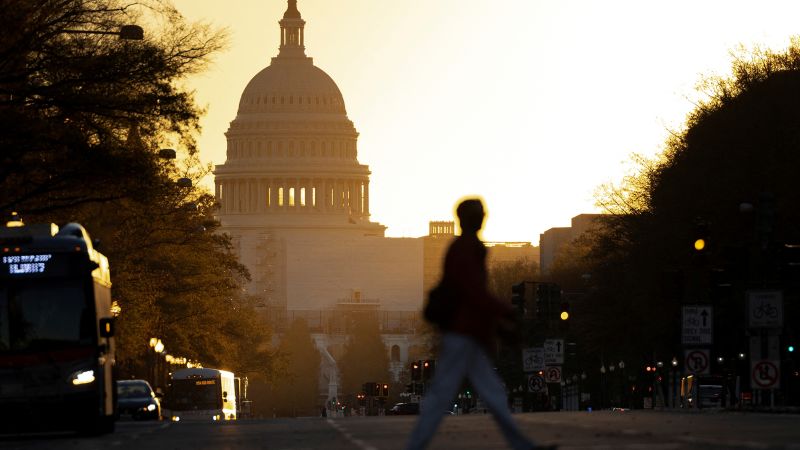

A version of this story appears in CNN’s What Matters newsletter. To get it in your inbox, sign up for free here.
CNN
—
The US has been in debt and arguing about it for its entire existence.
The only two years in US history when there was no debt came as then-President Andrew Jackson was blowing up the banking system and immediately preceded the Panic of 1837 and a major depression.
In recent decades, disagreements over raising the debt ceiling (the maximum amount of money the Treasury is authorized to borrow to pay its bills) have grown along with the size of the national debt. The country will likely reach its debt limit, which currently stands at $31.4 trillion, on Thursday.
There’s no denying the size of the debt is alarming, and not just because $31 trillion-plus is an eye-popping figure.
Economists like to assess the debt as a percentage of gross domestic product, or GDP, the broadest measure of the US economy. After pandemic recovery spending, the debt is about 120% of GDP, according to government figures. That’s historically high – higher than after World War II – but whether it’s a problem is the subject of much debate.
So-called “extraordinary measures” – the Treasury Department equivalent of moving money around to make interest payments – will give Congress and President Joe Biden until approximately June to come to an agreement on how to raise the debt ceiling.
RELATED: CNN’s Tami Luhby explains extraordinary measures
While there are clues to how this showdown will play out politically from other recent debt standoffs, there’s also reason to believe this time could be different – a larger portion of GOP lawmakers seem willing to allow the country to default and Biden seems unlikely to enact the kinds of spending cuts that would satisfy them.
Recent major conflagrations over the debt and spending, in 1995 and 2011, occurred under Democratic presidents who lost control of the House to Republicans.
It just so happens that we are in exactly that situation right now, albeit with a barely-there GOP majority instead of the strong ones enjoyed by then-House Speakers Newt Gingrich (in 1995 and 1996) and John Boehner (in 2011 and 2012).
Those past examples offer a guide to what probably lies ahead as current speaker Kevin McCarthy tries to force spending cuts out of Biden.
It was a relatively novel concept to use the debt ceiling as leverage when Republicans took control of the House in 1995. Back then, the debt was less than $5 trillion and a little less than 65% of the GDP.
The debt ceiling was at first wrapped up in a spending bill. There was ultimately a government shutdown but no default on the national debt during a yearlong saga in which Republicans ultimately blinked on using the debt.
Then-President Bill Clinton at one point accused Gingrich of blackmail over spending and vetoed debt ceiling increases. They ultimately agreed to raise the debt ceiling after a separate spending bill was enacted. They also shook hands on balancing the federal budget with help from cuts and a roaring US economy before the tech bubble burst.
Tax cuts and the post-9/11 wars enacted by Clinton’s successor, George W. Bush, ended the brief era of the balanced budget. The fact that the balanced budget barely affected the national debt at the time is the subject for another story.
During subsequent debt standoffs in the Obama years, Clinton suggested the president should invoke new power in the 14th Amendment and simply cut Congress out of the debt ceiling equation.
Boehner and then-President Barack Obama dueled over spending and the debt ceiling for years starting in 2011, when the debt was about $16 trillion, or around half of what it is today.
Boehner and Obama agreed to across-the-board spending cuts – the Budget Control Act of 2011 – as an incentive to reach a larger agreement to control deficit spending but failed to reach that larger agreement before Boehner was nudged out of the speakership and Obama left office. It was an unpopular solution, and it took lawmakers years to finally end the system of spending caps.
Meantime, the country came so close to a default in 2011 that Standard & Poor’s downgraded the US credit rating, where it continues to be AA+ rather than the top-level AAA. That signaled to the world that the US, long considered the safest place in the world to invest money, may not make good on its debt obligations (other major rating agencies warned about the debt ceiling crisis but never lowered the US credit rating). S&P’s action temporarily sent the stock market plunging.
Then-Senate Majority Leader Mitch McConnell got creative, suggesting the president be able to raise the debt unless both houses of Congress vote to override his decision. That method was utilized in 2013.
In 2013, lawmakers voted for the first time to suspend the debt ceiling rather than raise it.
These suspensions of the debt ceiling recurred every few years alongside separate spending fights that caused a series of partial government shutdowns during the Obama and Donald Trump years. When Biden took office in 2021, Republicans returned to insisting on raising the debt ceiling rather than suspending it.
Here’s a good timeline from the Bipartisan Policy Center.
Democrats have shown no interest in using the debt ceiling to enact changes, even with Republican presidents.
During the Ronald Reagan and George H.W. Bush years, they utilized the Gephardt rule, named for former Rep. Richard Gephardt, to automatically tie the debt ceiling to spending bills.
In the more recent years when they’ve controlled the House (2007-2010 and 2019-2022), despite tax cuts and expensive wars that also drove deficit spending, Democrats worked to raise the debt ceiling when needed under then-Presidents George W. Bush and Trump.
And Republicans, when there’s a GOP president like Trump, have not made as much of an issue over the debt – although now Trump is encouraging fellow Republicans to use the debt to exact spending cuts from Biden.
If the 1995 and 2011 examples are a guide, there will ultimately be some kind of agreement for some kind of spending cuts. And this drama will continue for months as the Treasury Department exhausts extraordinary measures, which may last until June.
Annual government funding doesn’t expire until the end of September.
These two issues – the debt ceiling and government funding – have often been tackled together. In any event, 2023 is looking to be a year focused on debt and spending.
